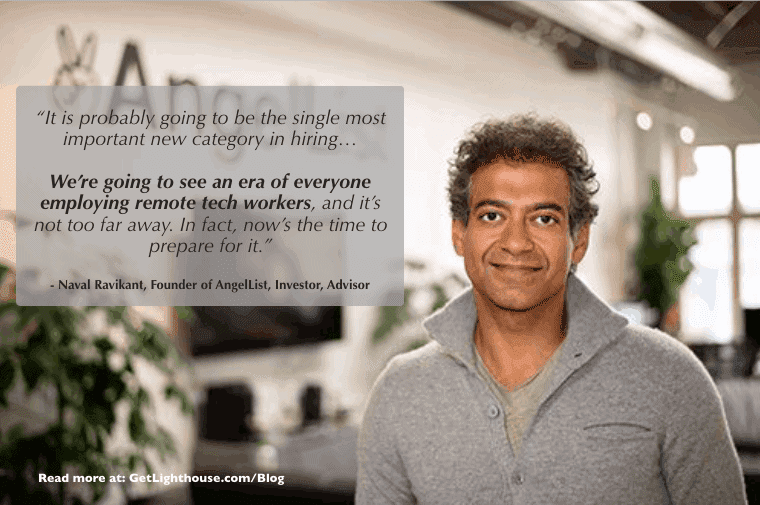How do you prepare for leading partially remote teams? What team-building activities can you use for employees with big generational gaps? And how can you teach your team to focus and prioritize properly?
Welcome to part three of "Ask Lighthouse”, our weekly format that finds solutions to your biggest workplace challenges. Each week, Jason Evanish, the CEO and founder of Lighthouse, and other leaders will share their advice based on their experience and lessons learned helping others.
The goal is to provide you with the nuance and detail that you can't find in our long-form posts that try to be more generally applicable.
You can send in your questions for next week here: Submit Your Questions Now
This Week's Ask Lighthouse: Managing Hybrid Teams, Team Building Activities for Everyone, Teaching Your Team how to Juggle Multiple Projects
With remote work likely to become the norm post-COVID, you've asked us about the following topics:
- Helping remote members of your hybrid team feel more included
- Teaching your people how to prioritize and not focus too heavily on one thing
- Coming up with team building activities all generations at your company can enjoy together (both remotely and in an office)
Here are actionable ways you can use to address these challenges and help your team.

Hybrid teams is one of our biggest workplace challenges
Question #1: "How do you lead a hybrid team effectively? What are some best tips, tools, and practices to make everyone feel included?"
Unfortunately, your remote people are going to feel like second class citizens unless you put in a lot of effort to make them feel included with those that return to your office.
The first and easiest solution is having them visit as often as possible, especially as COVID ends. However, budgets and other constraints usually limits that to at most once a month, but more likely 2-4 times a year.
On a day to day basis, make sure their work hours overlap with yours so you can have video calls and other synchronous communication with them. Adopt a culture where everyone (both in-office and remote people) join meetings through video. This will help your distributed teams avoid feeling isolated and excluded as it can be odd and uncomfortable to be on video and everyone else is sitting around a table together.
Leading partially remote teams can get extremely difficult, so watch out for the following mistakes to ensure everyone is treated the same way:
- Information inequality - understand your distributed people can't overhear conversations across the office, so keep thinking about what they may be missing and bring that up during 1:1s.
- Social disconnect - remote workers can't join you for a drink or a meal after work. Try to think of at least one activity per month everyone on your team can participate in even remotely. See question #3 for some great recommendations we got from asking Jason's followers on Twitter.
- Lack of growth - studies have shown career growth is one of the most powerful motivators for employees. Too often, remote staff miss out on career opportunities due to less visibility, but if you're really committed to a hybrid approach you need to invest in it.
Leading hybrid teams requires a lot of effort, awareness, and skill. Treat your remote employees like equals by compensating for anything they miss by not being in an office.
Take more time to understand their concerns in your 1:1s. Include them in as many team activities as possible, and you'll put them in a position to be as productive and engaged as the rest of your people in person.
If you're looking for further reading on the subject, these posts can help:
- The 5 Major Pitfalls of Managing a Partially Remote Team
- Tips for managing remote employees
- More common mistakes made with remote workers

How to increase workplace productivity
Question #2: "What are techniques a manager can use to help an employee who is laser-focused and detail-oriented? We want them to learn to juggle more than one project at a time. Not all projects require 100% of that employee's time on just that project."
Helping people manage multiple projects is a skill everyone needs to master as they grow in their career. Doing more in the same amount of time is a part of being a truly productive person.
Now, we know that multi-tasking generally can lead to lower performance, so the key is to teach your team members good time and priority management.
Use these concepts to help your team member understand how they can actually manage multiple projects without feeling like they need to work 24/7.

Apply the Pareto Principle (aka- the 80/20 rule)
One of the more oft-quoted concepts, the Pareto Principle explains that "for many outcomes, roughly 80% of consequences come from 20% of the causes.”
What does this mean for your team members?
Put time into analyzing the value and outcome of each of their tasks. Ask them the following question:
Which tasks can have the biggest impact on the outcomes you're aiming for? (i.e. - the 20%)
Let your team reflect on the high-value activities they're capable of doing. Are they focusing on the 20% of their work that will bring about 80% of the consequences? Or are they completing a lot of menial tasks that provide little value but take up precious time?
Help them think through where they may be doing work that doesn't move the bottom line. If there's a lot of it, something needs to change. Those tasks either need to be left to someone else or completely removed from their to-do list, which brings us to our next point.
Prioritize $100/hr tasks
Challenge your team to consider which parts of their work are really important, high-skilled, impactful tasks (aka- $100/hr tasks), and which are $10/hr or lower-value tasks that deserve less dedication and energy.
If a team member is spending way too much of their time on admin tasks, filing things, formatting, and manual, repetitive tasks, they're blocking themselves from doing higher impact work that puts their best skills to use.
Teach them how to delegate these low-value tasks, by letting them know who could do a task instead. You can also talk to them about tools that can help, as a small monthly fee for something that saves them hours or days every month is totally worth it for both of you.

Teach people to schedule and prioritize their work, even thinking time
Your team should use their calendar to schedule their most important thinking and strategizing time just like all the status update, brainstorming, and decision making meetings they have.
This idea comes from The 12 Week Year, which recommends two 3-hour blocks of time on your calendar each week.
While what you do in those blocks can vary based on your responsibilities, and current projects, the point is to carve out enough time to really decompress and reflect on your biggest challenges and opportunities.
By combining these three principles, your team will learn how to prioritize what really matters while also keeping the bigger picture in mind.
With that in mind, you can bring this altogether with a great analogy you can show them to really drive your point home, so they get the right things done, not just a lot of things:
For more lessons on priority management and improving productivity, check out the following links:
- Why Priority Management Trumps Time Management
- Mindfulness at Work: How Mindfulness Can Make You a Better Manager
- 8 Ways to Address Your Workplace Stress You Can Start Today

Do generational differences in the workplace mean anything for choosing team building activities?
Question #3: "What are some team-building activities for employees with big generational gaps?"
Recognizing everyone on your team is a unique individual is more important than generational differences. In fact, according to IBM report, just 0 to 2 percent of work attitude differences are attributable to generation.
Most of us enjoy some similar activities and subjects, so focus on what your team has in common instead of what makes them different.

In-person activities
Team dinners, drinks, and other meals generally work for everyone, and will play an important role for team morale as soon as COVID ends.
Depending on your team's interests, you can also try cross-generationally enjoyable things like watching sports or movies, organizing a book club, or going for an easy team hike, etc.
Of course, things can get complicated if you're looking for something that works for college graduates, folks approaching retirement, parents, and other groups at very different stages of their lives.
This is where mentoring can be a big win for you. Mentoring gives people of different ages a reason to connect in a professional and mutually beneficial way. It also ignores how different their personal lives may be.
Remote activities
Activities with remote team members are much more difficult to organize. The fact everyone has to sit or stand in front of a screen the entire time makes your options limited.
If you want to truly connect with your remote people, you should try retreats at least a couple of times a year. Get the team together for things like hikes, dinners, and group discussions to make up for the social isolation issues caused by your daily physical distance.
Then, to compliment your retreats and flying people to your office, try some of the recommendations we've received from Jason's followers on Twitter that you can do any time:
zoom gameshow
— Andreas Klinger 🏝 (@andreasklinger) June 22, 2021
can be with funfacts about employees, hotseats, etc
On Slack:
— Erik Dungan (@callmeed) June 22, 2021
1. Bonding/ice-breaker questions on Friday
Scheduled/zoom:
1. Pub-style team trivia
2. Games (Among Us, Codenames)
3. Virtual escape rooms
4. Hometown tours
5. Lightning talks on a non-work passion
Bonus: do over lunch or dinner and get everyone Uber eats credits
We've done a few airbnb experiences over zoom that have worked well. Recommend keeping the zoom running after the class so you can all compare notes or show off what you just made.
— 𝚔𝚊𝚝𝚎 (@katebennet) June 22, 2021
We've also written a detailed post about managing generational differences you can check out now.
What are Your Biggest Workplace Challenges? Let us Know!
At Lighthouse, we're always collecting feedback and looking for ways to help you improve.
What are your biggest leadership challenges right now? Let us know by submitting your question for next week here.
We'll anonymize anything needed to respect your privacy, and you'll get an answer to your biggest challenge right now.
Are you growing as a leader? Are you building the skills you need?
Whether your team is in office with you or remote, Lighthouse Lessons can teach you the skills you need to better lead, motivate, and grow your team. Let us help you navigate the unique challenges of being a leader like we helped Daniel by learning more and signing up here.





